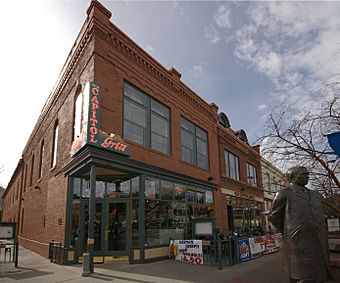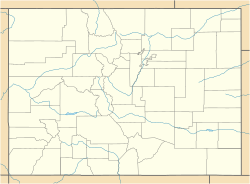Loveland Block and Coors Building facts for kids
Quick facts for kids |
|
|
Loveland Building and Coors Building
|
|

Loveland Block (on corner), with Coors Building at right
|
|
| Location | 1122 and 1120 Washington Ave, Golden, Colorado |
|---|---|
| Built | 1863 & 1906 |
| Built by | P.O. Unger |
| Architectural style | Early Commercial |
| NRHP reference No. | 96000544 |
| Added to NRHP | May 16, 1996 |
The Loveland Block and the Coors Building are two old and important buildings in downtown Golden, Colorado. They are right next to each other. The Loveland Block is named after a pioneer named William A.H. Loveland. This building was once the main government building, or capitol, for the Colorado Territory.
Both buildings are listed together on the National Register of Historic Places. This means they are recognized as very important historical sites. The Loveland Building is made of brick and has two stories. The front part was built in 1863, and the back part was added a few years later, around 1865-1866.
Contents
History of the Loveland Block
The Loveland Block was first built in 1863. This is shown on a special stone called a cornerstone on the building. It was built by William A.H. Loveland and a group called Golden City Lodge #1. This was the first Masonic lodge in Colorado.
William Loveland used the first floor for his store, which sold many different goods. The second floor was used by the Masonic group as their meeting hall. Building this large structure showed that Golden was strong, even during the American Civil War.
Serving as the Capitol
In the mid-1860s, Loveland added more space to the building. He wanted to make it big enough for the Colorado Territorial government. Before this, the government groups met in different buildings.
By 1866, the building was much larger. The House of Representatives met in the Masonic Hall on the second floor. The Council, which was like the Senate, met at the other end of the upper floor. There were also rooms for committees and a library.
The Colorado government met in this building from 1866 to 1867. This made the Loveland Block a very important place for Colorado's early history.
The Famous Mercantile Store
After Golden was no longer the capital, the Loveland Block was used for other important things. It became the main office for the Colorado Central Railroad. This was the first train line to go into the Colorado mountains.
Later, in 1878, the upper floor became a temporary home for the Colorado School of Mines. Their original campus had been damaged by fire. In the 1890s, the top floor was even used as a hotel.
But the building is best known for being "The Mercantile." This store was started by Loveland in 1859. It was a very popular store in Golden for 119 years, finally closing in 1978. For 57 of those years, it was run by the Koenig family. After the store closed, the building became a restaurant.
Building Changes Over Time
The Loveland Block has changed its look several times. In 1868, a third story was added to the building. In 1905, the first floor was updated with large glass windows. A very heavy, two-ton safe was also put in.
More changes happened in 1922, making the upper part of the store look more modern. The building's cornerstone was removed and given to the Masonic group. In 1992, the front of the store was updated again to look more like it did in 1922.
In 2005, a big fire damaged the building. After the fire, the inside was completely rebuilt and made stronger. New windows were put in that looked more like the original ones. Even the old chimneys on the side of the building were put back, making it look even more historic than before the fire.
History of the Coors Building
The Coors Building has an interesting past too. Its oldest part is the north wall, which was part of an earlier building from 1873. That building was a grocery store, then a bakery, and later a saloon.
In 1906, Adolph Coors tore down most of that old building. He built a new saloon and a place to bottle drinks. This was because he couldn't bottle drinks at his brewery at that time. The new Coors Building was designed by the Baeressen Brothers.
The main business in the new Coors Building was a saloon. Later, in 1907, a grocery store called the City Market moved in and stayed for many years. Over time, the building had different businesses and its first floor was updated.
In 1992, the Coors Building was renovated to look more like its original design. Its inside space was joined with the Loveland Block to become part of the restaurant. The Coors Building was also damaged by water in the 2005 fire, but it has since been fully repaired. Today, you can still see the "COORS" sign at the top of the building.



